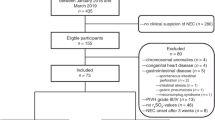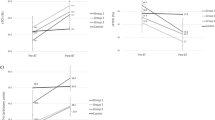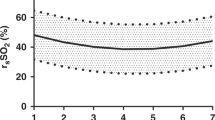Abstract
Objective:
Near-infrared spectroscopy (NIRS) is used to monitor brain and kidney perfusion in at-risk premature and term neonates. Although NIRS holds potential for bedside monitoring of intestinal perfusion, there is insufficient evidence showing correlation with mesenteric blood flow. To determine if an association exists between abdominal regional oxygen saturation (A-rSO2) and mesenteric blood flow, we compared changes in A-rSO2 to changes in blood flow velocity in the superior mesenteric artery (SMA) before and after feedings in very-low birthweight infants.
Study Design:
A-rSO2 was continuously monitored midline below the umbilicus for 3 days in 18 stable 25 to 31 week bolus-fed infants (median BW 1203 g, median age 5 days). We compared change in SMA velocity from immediately before to 10 min and 60 to 120 min after feeding with change in A-rSO2 over the same time. Spearman’s rank correlation was used to ascertain if a significant association existed.
Result:
Change in A-rSO2 was significantly associated with change in systolic, diastolic, and mean SMA velocity from fasting to 60 to 120 min after feeding (P=0.016, 0.021, 0.010) and from 10 min after a feed to 60 to 120 min after feeding (P=0.009, 0.035, 0.032).
Conclusion:
In very preterm infants, A-rSO2 reflects blood flow in the SMA and can provide non-invasive continuous monitoring of intestinal perfusion. Further studies are indicated to determine the sensitivity of NIRS to detect early intestinal pathology in this population.
This is a preview of subscription content, access via your institution
Access options
Subscribe to this journal
Receive 12 print issues and online access
$259.00 per year
only $21.58 per issue
Buy this article
- Purchase on Springer Link
- Instant access to full article PDF
Prices may be subject to local taxes which are calculated during checkout
Similar content being viewed by others
References
Crissinger KD . Animal models of necrotizing enterocolitis. J Pediatr Gastroenterol Nutr 1995; 20 (1): 17–22.
Murdoch EM, Sinha AK, Shanmugalingam ST, Smith GC, Kempley ST . Doppler flow velocimetry in the superior mesenteric artery on the first day of life in preterm infants and the risk of neonatal necrotizing enterocolitis. Pediatrics 2006; 118 (5): 1999–2003.
Robel-Tillig E, Knupfer M, Pulzer F, Vogtmann C . Blood flow parameters of the superior mesenteric artery as an early predictor of intestinal dysmotility in preterm infants. Pediatr Radiol 2004; 34 (12): 958–962.
Hackett GA, Campbell S, Gamsu H, Cohen-Overbeek T, Pearce JM . Doppler studies in the growth retarded fetus and prediction of neonatal necrotising enterocolitis, haemorrhage, and neonatal morbidity. Br Med J (Clin Res Ed) 1987; 294 (6563): 13–16.
Meier SD, Eble BK, Stapleton GE, Morales DL, Chang AC, Andropoulos DB . Mesenteric oxyhemoglobin desaturation improves with patent ductus arteriosus ligation. J Perinatol 2006; 26 (9): 562–564.
Papacci P, Giannantonio C, Cota F, Latella C, Semeraro CM, Fioretti M et al. Neonatal colour doppler ultrasound study: Normal values of abdominal blood flow velocities in the neonate during the first month of life. Pediatr Radiol 2009; 39 (4): 328–335.
Lane AJ, Coombs RC, Evans DH, Levin RJ . Effect of feed interval and feed type on splanchnic haemodynamics. Arch Dis Child Fetal Neonatal Ed 1998; 79 (1): F49–F53.
Leidig E . Doppler analysis of superior mesenteric artery blood flow in preterm infants. Arch Dis Child 1989; 64 (4 Spec No): 476–480.
Martinussen M, Brubakk AM, Vik T, Yao AC . Mesenteric blood flow velocity and its relation to transitional circulatory adaptation in appropriate for gestational age preterm infants. Pediatr Res 1996; 39 (2): 275–280.
Van Bel F, Van Zwieten PH, Guit GL, Schipper J . Superior mesenteric artery blood flow velocity and estimated volume flow: duplex doppler us study of preterm and term neonates. Radiology 1990; 174 (1): 165–169.
Fang S, Kempley ST, Gamsu HR . Prediction of early tolerance to enteral feeding in preterm infants by measurement of superior mesenteric artery blood flow velocity. Arch Dis Child Fetal Neonatal Ed 2001; 85 (1): F42–F45.
Havranek T, Thompson Z, Carver JD . Factors that influence mesenteric artery blood flow velocity in newborn preterm infants. J Perinatol 2006; 26 (8): 493–497.
Cortez J, Gupta M, Amaram A, Pizzino J, Sawhney M, Sood BG . Noninvasive evaluation of splanchnic tissue oxygenation using near-infrared spectroscopy in preterm neonates. J Matern Fetal Neonatal Med 2011; 24 (4): 574–582.
Petrova A, Bhatt M, Mehta R . Regional tissue oxygenation in preterm born infants in association with echocardiographically significant patent ductus arteriosus. J Perinatol 2011; 31 (7): 460–464.
McNeill S, Gatenby JC, McElroy S, Engelhardt B . Normal cerebral, renal and abdominal regional oxygen saturations using near-infrared spectroscopy in preterm infants. J Perinatol 2011; 31 (1): 51–57.
Mintzer J, Dayan J, Gardner M, Master M, Chelala M, Alpan G et al. Real-time cerebral, splanchnic, and renal near-infrared spectroscopy (nirs) in very low birthweight neonates: An analysis of baseline variability. E-PAS20114521.311; 2011.
Mittnacht AJ . Near infrared spectroscopy in children at high risk of low perfusion. Curr Opin Anaesthesiol 2010; 23 (3): 342–347.
Acknowledgements
Funding: Research funding from VICTR voucher (Vanderbilt Institute for Clinical and Translational Research Grant 1 UL1 RR024975 from NCRR/NIH), an unrestricted educational grant from Somanetics/Covidien (to BE), and the National Institutes of Health (K08DK083677 to SJM). Database support from Redcap (Vanderbilt Institute for Clinical and Translational Research Grant 1 UL1 RR024975 from NCRR/NIH). A sincere thank you to the Department of Pediatric Ultrasound, without whom this research would not have been possible: Leah Marlar, Emily Maute, Cassidy Orton, Jessica Turner, and Yuangfang Wang.
Author information
Authors and Affiliations
Corresponding author
Ethics declarations
Competing interests
Dr Engelhardt received an unrestricted educational grant from the Somanetics Corporation (now Covidien, Boulder, CO, USA) which was used for equipment costs. Covidien had no role in the design of the study, collection or analysis of data. Mrs Cochrane and Drs Gillam-Krakauer, Polavarapu, McElroy, Slaughter and Hernanz-Schulman declare no potential conflicts of interest.
Rights and permissions
About this article
Cite this article
Gillam-Krakauer, M., Cochran, C., Slaughter, J. et al. Correlation of abdominal rSO2 with superior mesenteric artery velocities in preterm infants. J Perinatol 33, 609–612 (2013). https://doi.org/10.1038/jp.2013.3
Received:
Revised:
Accepted:
Published:
Issue Date:
DOI: https://doi.org/10.1038/jp.2013.3
Keywords
This article is cited by
-
Novel approaches to capturing and using continuous cardiorespiratory physiological data in hospitalized children
Pediatric Research (2023)
-
Abdominal Near Infrared Spectroscopy can be reliably used to measure splanchnic oxygenation changes in preterm infants
Journal of Perinatology (2023)
-
The effect of drip versus intermittent feeding on splanchnic oxygenation in preterm infants with intrauterine growth restriction: a prospective randomized trial
European Journal of Pediatrics (2023)
-
Splanchnic oxygen saturation during reoxygenation with 21% or 100% O2 in newborn piglets
Pediatric Research (2022)
-
Early brain and abdominal oxygenation in extremely low birth weight infants
Pediatric Research (2022)



